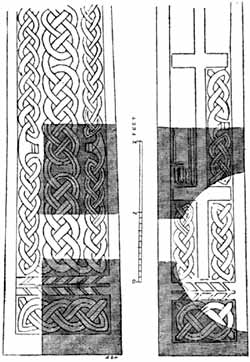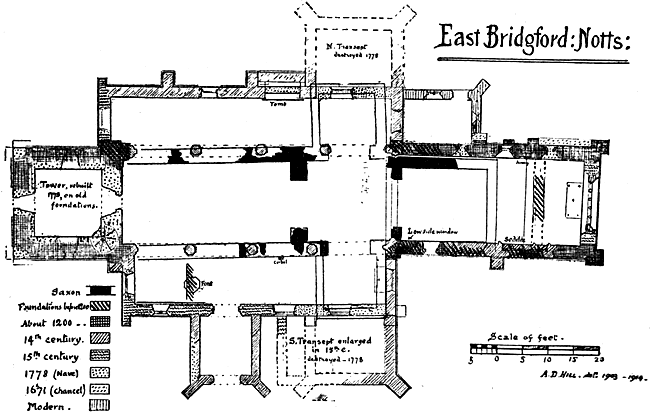A Saxon Church.

During the progress of the operations, some interesting facts have come to light about the earlier history of the church. Several fragments of Saxon shafts, including one which appears to be part of a fluted baluster, with well-marked entasis, all discoloured as if by fire, were noted in the description of this church in the 1903 volume of the Transactions. A portion of the north wall, and also of the north respond of a narrow Saxon chancel arch, 8ft. wide, were also found beneath the chancel floor in 1903. On referring to the plan of the church on page 50, it will be seen that the continuation of the earlier church has now been discovered beneath the floor of the nave. Its plan is that of a pre-Norman cross church, of the type of St. Mary's, Dover, with a central tower, 16ft. 6in. square, doubtless with transepts, and with a nave extending as far as the western end of the present nave, about 32ft. in length. A few red floor tiles, a foot square, were discovered in situ near the entrance to the north transept, 16 inches below the present nave level.
It will be noted that while the south wall corresponds with the present south arcade and chancel wall, the north wall is 1ft. to 2ft. within the modern line. There appears to be a somewhat puzzling discrepancy—the north wall of the nave not ranging with that of the chancel. It was unfortunately not practicable to clear up this fact, which seems to point to some rebuilding of the nave at a later period than that in which the chancel was built.

A Twelfth Century Rebuilding.
The Saxon church was succeeded by another, with western tower, rebuilt from the ground in the 12th century, though possibly a part of the south wall may have been left standing. The north wall was built outside the old line of foundations, so that the new church was about 2ft. wider. The nave was without aisles or transepts, for traces of flat external buttresses are still to be seen at three of its angles, and there was probably a south porch. A porch is indicated by a line of foundation to be seen in the plan under the font. This perhaps influenced the position of the doorway in the north aisle, which is further westward than the later south porch. It is additional evidence that the north aisle was built out some years earlier than the south aisle, as is indicated by the poorer finish of the capitals of the south arcade. A few fragments of Norman mouldings have turned up, and a small portion of a Norman font with a band of nail-head ornament, showing the existence of some work of that period. But the chancel of the last quarter of the 12th century, still remains, with its unusual nebule corbel table on the south side, its priest's door, and one lancet window,—the only survivor of six lateral and a triple-lancet east window. The chancel is 36ft. in length, and on the evidence of the foundations, is 10ft. longer than its immediate predecessor, which must have succeeded the still shorter chancel of the original Saxon church.
Fourteenth Century Work.
Early in the 14th century, the nave walls were pierced for arcades; and aisles, transepts, and a south porch were added. The western respond of the north arcade showed clear evidence of its insertion into an older and thicker wall.
An arched recess for a tomb, in the wall of the north aisle, originally projected on the outside to the line of the buttress, the plinth of which was carried straight across the projection to the transept wall. Thoroton states that it contained a slab inscribed Johannes Babington 1409, but the moulding of the arch indicates an earlier date. The outer crocketted member of the arch is destroyed, but a shield over it bearing the arms of Babington, ten roundels with a label of three points, is part of the original construction, and forms the sill of the window above. The recess now provides a resting place for a mutilated stone figure of a knight, probably Sir John Caltoft, about 1320, which was cast out of the church in 1778, when the transept in which his tomb stood was destroyed.
One other point of interest must be recorded. On the inner face of the north wall two holes were found, on either side of the north door, for the insertion of wooden bearers for a small gallery about 8ft. from the floor. There are traces of such galleries elsewhere, perhaps used for Palm Sunday ceremonies or miracle plays. In the churchwardens' accounts of St. Andrew Hubbard, Eastcheap, in London, there is an entry in 1480-2,—
"Paid for frame and workmanshippe over the Church door for Palm Sundaye . . . vijd."
Two interesting stones with interlaced strap-work ornament, noted in my account of the church in 1903, have now been taken out of the walls in which they were imbedded. They prove to be portions of a Saxon churchyard cross, showing patterns on two adjacent sides for about 2ft. 6in. in length. These are of the same open strap character as on the shafts at Hawksworth and Rolleston, and other fragmentary remains at Screveton and Kneesall, in this county. The development of the pattern is shown in the accompanying sketch, in which the shaded portion represents the existing stones. The broad face of the shaft was originally 20in. across at the base, and tapered slightly. It had three vertical sets of interlaced bands, of which one is lost. The side face of the shaft was 15in. wide, and bore a double cross with square-ended arms. The patterns on the other side and the back have been lost, for the stone has been cut up and re-used to form an arch, splayed on both sides, for a Norman round-headed shuttered window of about 16in. in the opening. From the frequent destruction of these crosses, as Mr. Romilly Allen shows, it seems likely that the Norman builders supposed them and their mysterious ornamentation to be pagan symbols, and the first thing they did was to break up all gravestones and crosses for building stone. The shaft was a single block of Lincolnshire limestone, and must have formed a noble ornament of the Saxon churchyard, standing at least 7ft. high. One of the two fragments is now used to support a credence in the side chapel, and the other is built into a new buttress of the south aisle.
When I first noticed these fragments of interlaced patterns imbedded in 18th century masonry, one in an external wall, and the other inside the upper stage of the tower, I suggested that the Saxon cross might have been still in existence in 1645; for in that year an entry of a burial is noted prope crucem in coemiterio " near the cross in the churchyard." But the discovery of Norman mutilation of the stones disproves this, and leaves us to regret the disappearance not only of the Saxon cross, but of a later medieval one as well.
For other points of historical or architectural interest in this church, reference may be made to the paper in the Transactions of the Thoroton Society, vol. vii., 1903; or to Mr. Godfrey's Churches of the Hundred of Bingham.
